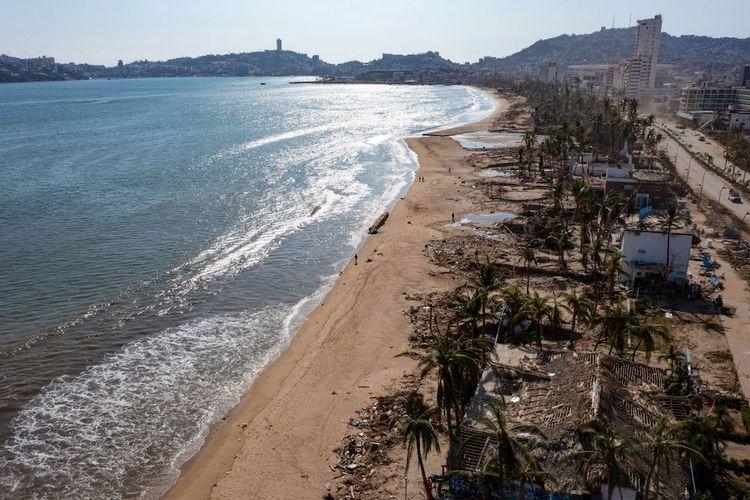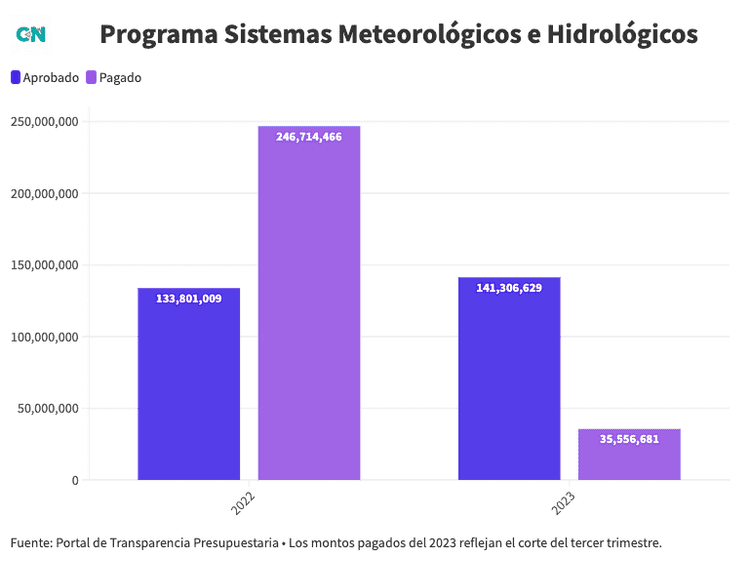Hurricane Otis highlighted the low priority that tropical cyclones have for the federal government. Mexico currently depends on U.S. forecasting services to respond to weather phenomena.
“In Mexico, more support for science is needed. I was telling you that forecasts are made in the United States and not in Mexico. There are forecasters in Mexico who take those forecasts from the United States and do a little closer. But we, a country always affected by hurricanes, should be able to generate our own forecasts and there should be money for hurricane research,” said researcher Ruth Cerezo Mota of the Engineering Institute of the National Autonomous University of Mexico of the Sisal unit.

Photo: Rogelio Morales/Cuartoscura.
Currently, prior to the hurricane season, it is the United States National Hurricane Center of the National Office of Oceanic and Atmospheric Administration (NOAA) that is responsible for generating forecasts.
By 2023, both the NOAA center and other forecasting agencies announced that the season on the Pacific side would be more active than normal, Cerezo explained.
The hurricane that hit the coast of Guerrero on October 24 left, until the October 29 cutoff, a total of 48 dead and dozens missing; in addition to extensive damage to housing and tourist infrastructure.
The National Hurricane Center indicates the trajectory and intensity of each storm. However, Otis had a precipitous evolution that baffled the forecasts. A Category 5 hurricane was not expected in the port of Acapulco. The speed of the intensification prevented the authorities from preparing.
“It is true that there has been scientific and computational progress that makes it possible to make a fairly accurate forecast of trajectories, where it continues to fail is in intensification,” explained the specialist in atmospheric physics about the challenges faced by these tropical storms.
In 12 hours, the force of the winds went from 133 kilometers per hour to 257. This is the record for the worst land entry record in the Eastern Pacific.
Modernization?
“The National Weather Service is the one who should be generating these forecasts. It has been talked about for many years. On the one hand, to modernize it and, on the other hand, to create a Hurricane Center. In this six-year term, people started talking about it, but there isn't really a forecasting center,” Cerezo said.
A modernization project of the National Weather Service (SMN) stipulated an investment of 84 million dollars.
However, the project was in a pre-investment phase and the following observation was noted on the official project page: “The project will no longer appear on the list of published projects as long as the possible resumption of this initiative is reconsidered”.
The SMN depends on the National Water Commission, which is part of the Secretariat of Environment and Natural Resources (Semarnat).
This year, the Federal Expenditure Budget did not allocate resources to the SMN investment program (it includes maintenance of buildings, machinery, among others).
Subsequently, the amount was changed to 14 million 529 thousand pesos by 2023. This is just 21.7% of the 66 million 822 thousand pesos that were spent in 2022.

“The Meteorological Service has always been with fewer employees than it should have, considering the national territory and that when there are no hurricanes we have droughts, frosts, norts, a thousand and one phenomena of different scales in different regions of the country... it only responds to emergencies, rather than long-term things,” Cerezo explained.
Different from the investment issue, in 2016 the National Weather Service program (resources for its operation) merged with that of Meteorological and Hydrological Systems.
The latter retains both names and has a budget approved this year of 141 million pesos, an increase of 5.6% compared to what was approved last year, but a drop of 42.7% compared to the 246 million that were finally executed in 2022 under this program.

Hurricanes to come
Climate change affects meteorological phenomena, although several factors influence the case of Otis.
“The fact that the ocean is warmer than normal, this anomalous warming is a consequence of global warming, let's say that could be a relationship, but it's also true that right now the Pacific is much warmer than normal with the El Niño phenomenon and it's a natural phenomenon. So let's say that these two issues are added together,” Cerezo said.
The expert indicated that one of the conditions for a hurricane is that there is some instability in the atmosphere, however, when you have an increase in temperature either because of El Niño (which heats the waters of the Pacific Ocean) or because of global warming, this instability is lost.
On the other hand, another condition for a hurricane to occur are very hot oceans, something that does happen persistently.
“The theory suggests that you can't increase from an increase in the frequency of hurricanes. However, when the conditions are met for them to occur, they are much more likely to be of a higher category. So, it's not that there will be more hurricanes in the future, but if they do, the probability of them being of a higher category is higher,” Cerezo said.
Climate Policy
Building on the damage caused by Hurricane Otis, a group of civil organizations issued a statement on October 26 calling on the government to implement a climate policy.

Photo: Rogelio Morales/Cuartoscura.
The federal government has launched 20 measures to serve the population, most of them benefits from social programs to support the population, cessation of service collection and rehabilitation of infrastructure.
However, there are other issues to analyze, said Pablo Montaño, coordinator of the organization Climate Connections.
“There should be an in-depth analysis of the climate vulnerability that this country faces and as long as Mexico does not have a climate policy up to the challenge, we will continue to face humanitarian disasters over and over again,” Montaño said.
The alerts generated by Otis are a national priority, but other parts of the country are also suffering from inclement weather, Montaño said.
For example, November began with the evacuation of the El Bosque community, in Tabasco, which disappears by sea.
“These are climate realities and it is important to understand the urgency of a climate policy commensurate with the disaster we are experiencing, not only to respond to the people who are affected, but to prevent more from being affected, because this will continue to increase. That's what we're talking about when we say that there is an urgency for a real, forceful and clear policy,” Montaño said.
In their statement, the organizations have emphasized that the federal government has focused more on upholding its fossil policy, which Montaño says is incompatible with the actions that the country should implement in the face of climate change.
“The most important thing is to understand that climate aspects do not respond to political will, so it is a pressing reality that we have before us for which time has been wasted,” said the coordinator.



Comentarios (0)